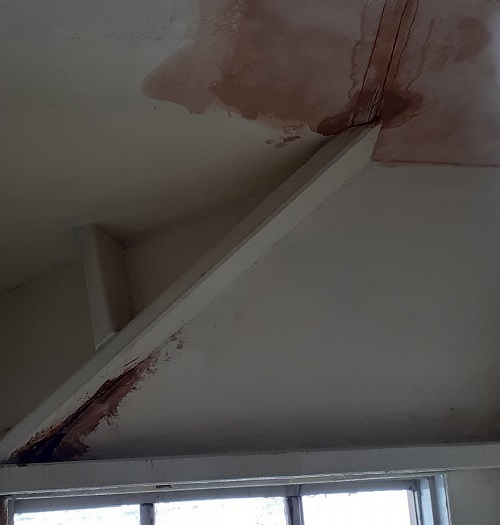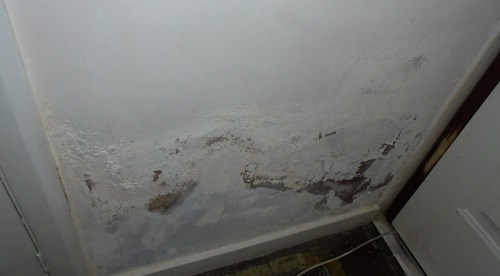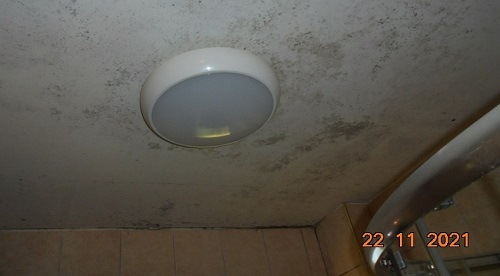We will be doing maintenance to our website systems on Friday, 26 and Sunday, 28 April. more »

Types and causes of damp
Penetrating damp

Penetrating damp is caused when water enters a property from the outside. This is usually caused by defects in the outside wall, damaged brickwork and pointing, rotten gutters, holes or slipped slates to the roof. Because of the way it enters the property, it usually appears as damp patches on inside walls.
It is your landlord’s responsibility to ensure that all parts of the building are in good repair to prevent penetrating damp. You must contact your landlord in writing to tell them you are experiencing issues with penetrating damp, giving them opportunity to resolve the problem. If the landlord does not deal with the problem then contact Housing Standards on 01274 434520.
Rising damp

Rising damp is the name given to the process of water in the ground entering a property by travelling up through the pores in brickwork. It is typically seen as a ‘tide mark’ on the walls.
Rising damp may need to be treated by your landlord depending on how serious it is by installation of a damp proof course. If your walls have a visible tide mark and the plaster is damaged then you must inform your landlord. If the landlord does not deal with the problem then contact Housing Standards on 01274 434520.
Condensation mould

This type of damp is typically seen as black mould on external walls and ceilings. Condensation occurs when moist air comes into contact with a colder surface like a wall, window or mirror. The air can’t hold the moisture and tiny drops of water appear. It also occurs in places the air is still, like the corners of rooms, behind furniture or inside wardrobes.
How to reduce condensation at home
Produce less moisture
Simple things make a huge difference, like keeping the lids on pans when cooking, drying clothes outdoors (and especially not on radiators), venting your tumble dryer to the outside and avoiding using paraffin heaters or flue-less bottled gas heaters which produce a lot of moisture.
Let the moist air out and the fresh air in
Stop moist air getting into the rest of your home. When cooking or bathing, keep the kitchen or bathroom door shut and open the window so that the steam goes outside instead.
Extractor fans are an effective way to get rid of moist air and steam so that less condensation forms. Some homes have extractor fans which run continuously, fitted in the ceilings of bath and shower rooms. They use very little electricity.
Meanwhile, let fresh air circulate to avoid mould forming where the air is still. Make sure there is a gap between your furniture and the walls, and give wardrobes and cupboards a good airing sometimes.
If your home doesn’t already have extractor fans then it's well worth asking your landlord to fit them in the bathroom and kitchen. Fans that run on a timer, humidistat or pull-cord typically have a rating of 8 to 30W. A 30W appliance would need to run continuously for nearly a day and a half to use one unit (about 15p) of electricity.
Insulate and draught-proof your home
Warm homes suffer less from condensation, so you should make sure your house is well insulated. This means insulating your loft to the recommended depth of 270mm (about 11 inches), and your cavity walls (if your house has them). Your windows and external doors should be draught-proofed, and you should consider secondary glazing if your windows are draughty. Your landlord is responsible for ensuring the insulation is adequate in your home. If you think that the loft is not insulated and your landlord is refusing to undertake the work contact Housing Standards on 01274 434520.
Heat your home a little more
While you don’t want to waste money heating rooms you don’t use, very cold rooms are more likely to get damp and mould. Set the thermostatic radiator valve to 1 in unused rooms so the radiator gives out a little bit of heat whenever you have the heating on. If you don’t have central heating, consider using a room heater with a timer and temperature control. Remember, unused rooms will need a good airing from time to time.
Other helpful equipment
You can catch condensation dripping from windows with condensation channels and sponge strips (available from DIY shops). If you wipe down windows and sills in the morning this will also help, but be sure to wring out the cloth rather than dry it on a radiator. In extreme circumstances you may need to invest in a dehumidifier.
How to get rid of mould
If you already have mould on your walls and ceilings then you need to clean it off properly. An effective two-stage method is to start by cleaning off the mould with spray containing bleach. This will help remove the staining that persistent mould can leave behind. Leave to dry overnight and then spray the affected area with an anti-fungal wash and allow that to dry. Always follow the manufacturer’s instructions and consider wearing a face mask when spraying.
You could also treat the affected area with a mould-resistant paint, available from most major hardware stores.

